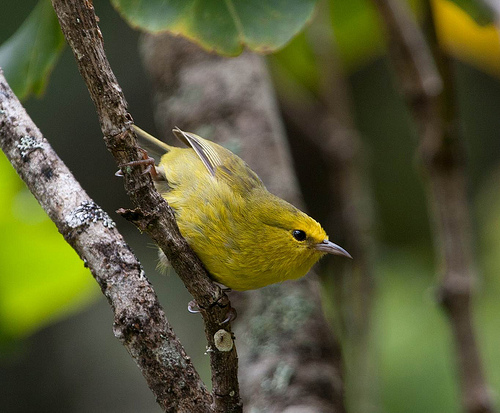Alien Forest Use
A Graduate Research ProjectALIEN FOREST USE
Due to extensive habitat destruction, the Maui ‘Alauahio (Paroreomyza montana) occurs in two known disjunct populations where habitat conditions vary extensively. The primary population occurs in wet and mesic montane native forests dominated by ʻōhiʻa (Metrosideros polymorpha). The second separate population occurs in non-native forests within Polipoli State Recreation Area or Kula Forest Reserve. These birds may express differences in their behavior and ecology that have allowed them to exploit these novel environments. The Polipoli population lives in dry and mesic forests that were originally koa (Acacia koa.), māmane (Sophora chrysophylla.) and ʻōhiʻa. However, after an experimental forest project in the 1930s it is now dominated by non-native plants, like pine (Pinus spp.), eucalyptus (Eucalyptus spp.), ash (Fraxinus spp.), redwood (Sequoia spp.) and cedar (Thuja spp).
A graduate student through Northern Arizona University ,Peter Motyka, in conjunction with MFBRP began research to investigate the use of non-native forest by native birds to facilitate the ability to evaluate the management of non-native forest for the benefit of native forest bird species. The objectives of this study were to: 1.) Conduct a multi-scale assessment of habitat use by the Maui ‘Alauahio in the Kula Forest Reserve; 2.) Determine the occurrence, distribution, and variable densities of Maui ‘Alauahio in the Kula Forest Reserve; 3.) Investigate potential correlations between bird occurrence and vegetation composition and structure; and 4.) Investigate home range and nesting substrates of Maui ‘Alauahio to determine habitat preference. The project included color-banding and resighting Maui ‘Alauahio, quantification of vegetation structure for foraging habits, variable circular plot point counts for bird densities, and nest searching and monitoring for Maui ‘Alauahio. Read the full thesis here.
Because of this initial study on native bird use of non-native forest, MFBRP now conducts Hawai’i Forest Bird Surveys in this area as well as population monitoring– with bird banding and disease prevalence- studies.
The remaining native forests on Maui are small and in order to prevent further extinctions conservation efforts may need to consider the value of non-native, fragmented habitats as well. It is important to examine responses of species and ecosystems to landscape modification. This study advanced both our ability to make conservation management recommendations as well as our perception of the potential for managing unnaturally altered habitat areas for the benefit and support of native species.
If you are interested in becoming an MFBRP graduate student, please visit here.


Save the Forest, Save the Birds
It takes a community of dedicated individuals and support to make conservation happen
